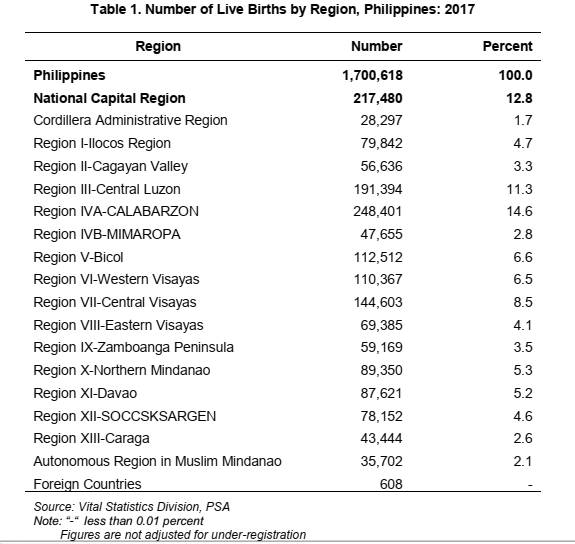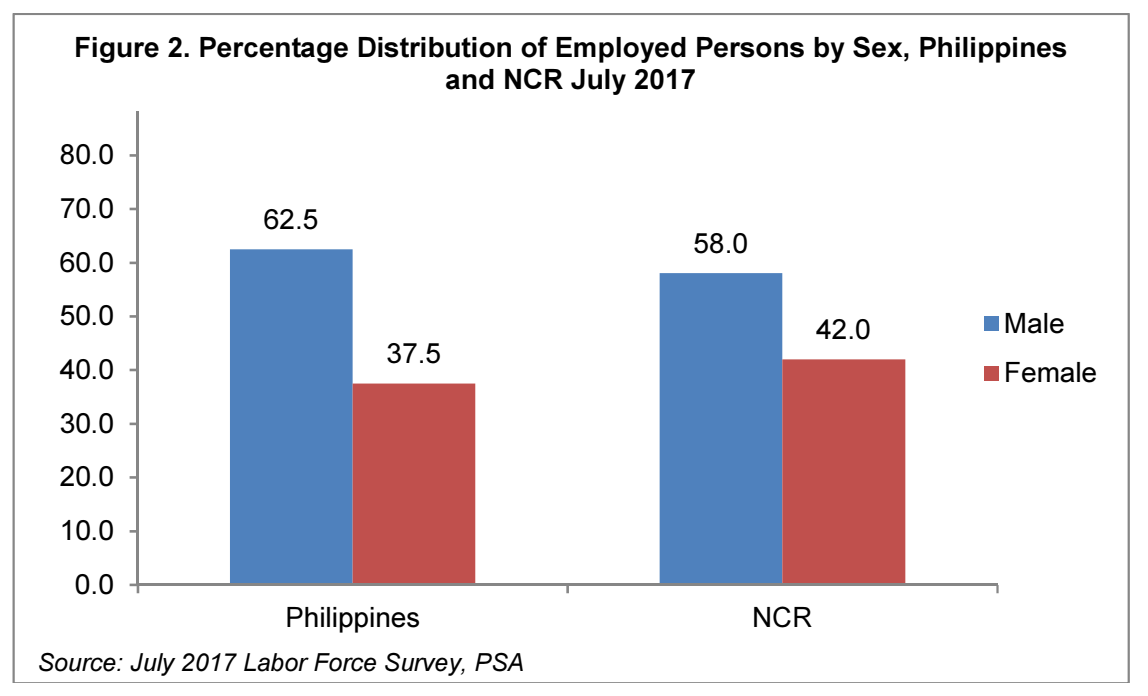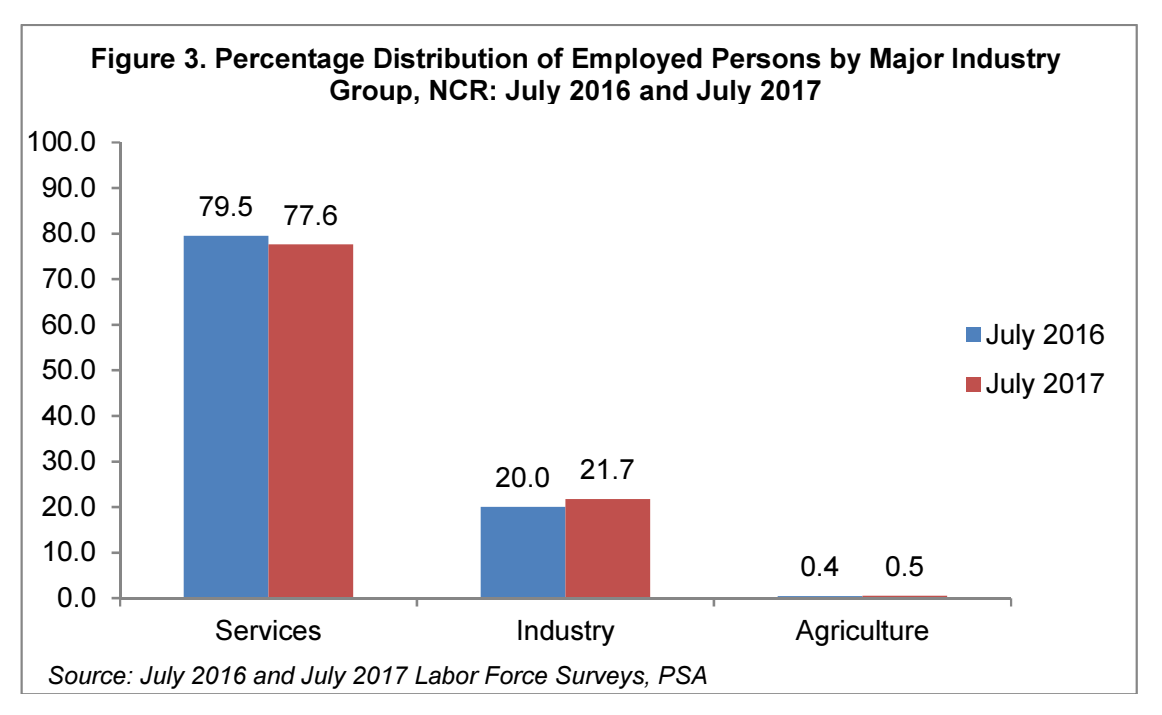This special release presents data on birth which occurred in 2017 and was registered from January 2017 to March 2018. Statistics on this vital event were based on information obtained from the birth certificates transmitted by the City/Municipal Civil Registrars to the Office of the Civil Registrar General of the Philippine Statistics Authority (PSA) for processing and archiving. Figures presented are not adjusted for underregistration.
NCR registered live births at 12.8 percent in 2017
Of the total births (1,700,618) in the country, 657,275 or 38.6 percent was accounted for by three regions in Luzon. On top of the list was the CALABARZON with 248,401 (14.6%) followed by National Capital Region and Central Luzon with 217,480 (12.8%) and 191,394 (11.3%), respectively. The rest of the regions in the country contributed less than ten percent each to the total number of births in 2017.

NCR registered top among sixteen regions in terms of place of occurrence of live births
Seven out of 17 regions in the country showed a positive difference in the number of birth by place of occurrence and the usual place of residence of the mother. This implies that there were mother who opted to temporarily migrate to places where there are available or better health care facilities and social services.
The highest positive difference of 21,157 was reported in NCR, where the most number of hospitals and health care facilities are located. On the other hand, the highest negative difference of 17,782 was accounted in CALABARZON. Refer to Table 2 for details.

NCR live birth decrease by 1.1 percent in 2017
There were 1,700,618 live births registered in the country in 2017, recording a decrease of 1.8 percent from the 2016 figure of 1,731,289. NCR recorded a total of 217,480 registered live births in 2017 or 1.1 percent decrease from 219,936 in 2016. Of the total registered live births in NCR, 113,263 or 52.1 percent were males and 104,217 or 47.9 percent were females.
The figure below shows the percent distribution of Live Birth by Sex, Philippines and NCR for the 2017.

An average of 25 babies are born per hour in NCR
The total live birth registered in the entire country in 2017, numbering 1,700,618 has an average of 4,659 babies born daily or 194 babies born per hour or three babies per minute. In NCR, a total of 217,480 live births recorded in 2017 or an average of 596 babies born daily or 25 babies born per hour. Refer to Table 3 for details.

Quezon City dominates the total number of live birth registered in NCR
Among 16 cities and one municipality in NCR, Quezon City had the highest number of live births registered in 2017 with a total of 48,899 or 22.5 percent. This was followed by City of Manila with 31,536 (14.5%) and Caloocan City with 27,531 (12.7%). On the other hand, the municipality of Pateros had the lowest number of live births registered with 887 or 0.4 percent. Refer to Table 4 for details.


Nine out of ten live births are medically attended
In NCR, a total of 211,425 or 97.2 percent of registered birth deliveries were attended by medical practitioners who may either be a physician, nurse or a midwife. On the other hand, 6,047 or 2.8 percent of babies born were attended by traditional and other birth attendants. Refer to Table 5 for details.

Explanatory Notes
Introduction
Vital statistics are derived from information obtained at the time when the occurrences of vital events and their characteristics are inscribed in a civil register.
Vital acts and events are the births, deaths, fetal deaths, marriages, and all such events that have something to do with an individual’s entrance and departure from life together with the changes in civil status that may occur to a person during his lifetime. Recording of these events in the civil register is known as a vital or civil registration and the resulting documents are called vital records.
The structure of vital statistics system
The production of vital statistics comprised of the system of operation in which the registration of vital events is an important component. The system begins with the registration followed by processing and controlling of vital records and ends with the compilation and analysis of vital statistics.
Under commonwealth Act 591, the Bureau of Census (now PSA) is mandated to generate general purpose statistics and to carry out administer Act No. 3753.
Under the same law, the head of the NSO (now part of PSA) is also the Civil Registrar General (CRG) who directs and supervises the local civil registration activities in the country. The CRG in this regard is empowered to issue implementing rules and regulation on civil registration for proper compliance and, to design and order the printing of the necessary forms.
The vital statistics system involves different entities and cutting across different departments and personalities.
For the registration of vital events, the Local Civil Registry Offices (LCROs), which are the registration units in the country and headed by the City/Municipal Civil Registrars (C/MCRs), are under the Local Government Units (LGUs). The hospitals, clinics, rural health units and similar institutions including barangay secretaries, practicing physicians, midwives, nurses, traditional midwives, solemnizing officers from various religious sects and denomination are required to assists in the reporting of vital events for registration at the LCROs. The concerned parents, next of kin, contracting parties, witness or the person who has full knowledge of the occurrence of the events are also required to report the event, in default of the first mentioned set of informants.
The processing and controlling of vital documents are done at the LCROs and at the PSA Provincial and Central Offices.
The compilation and analysis of vital statistics is taken cared of by PSA central offices under the Vital Statistics Division (VSD) of the Civil Registration Service Office.
The Registration Method
As mandated in Act 3753, all vital events that marked the entry and departure of a person of his lifetime and the changes in his/her civil status shall be registered. The registration method is defined as continuous, permanent and compulsory recording of the occurrences and characteristics of vital events, primarily for their value as legal documents and secondary for their usefulness as a source of statistics.
Where to register the event
As a general rule, vital events should be registered at the LCRO where the events occur. In special cases, where the document about a vital event is presented to the LCRO which is not the place of occurrence, the same maybe accepted and is considered as out-of-town reporting. However, such documents should not be registered by the receiving LCRO. It must be forwarded to the LCRO where the event took place for purpose of registration.
Definition of terms and Concepts
This section presents the significant terminologist and descriptions in the foregoing highlights and tables are defined below. Included are some items found in the certificates and summary measure used in the certificates and summary used in the describing the facts of events.
Vital statistics on the other hand, are derived from information obtained at the time when the occurrences of vital events and their characteristics are inscribed in a civil register.
Live Birth is a complete expulsion or extraction from its mother of a product of conception, irrespective of the duration of the pregnancy, which after such separation, breathes or shows any other evidence of life, such as beating of the heart, pulsation of the umbilical cord, or definite movement of the voluntary muscles, whether or not the umbilical cord has been cut or the placenta is attached: each product of such a birth is considered live born.
Usual Residence refers to the place where the person habitually or permanently residences.
Place of Occurrence refers to the place where the vital event took place.
Source: Vital Statistics Division, PSA
For more details, please visit
(SGD)
PACIANO B. DIZON
Regional Director
